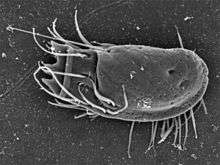Stephanopogon
Stephanopogon is a genus of flagellate marine protozoan that superficially resembles a ciliate.
| Stephanopogon | |
|---|---|
 | |
| Stephanopogon sp. | |
| Scientific classification | |
| Domain: | Eukaryota |
| (unranked): | |
| Phylum: | |
| Class: | |
| Order: | Pseudociliatida Corliss & Lipscomb 1982 |
| Genus: | Stephanopogon Entz 1884 |
Characteristics
It closely resembles certain ciliates and was originally classified with them, but is now considered related to heterolobosean flagellates. The cell is somewhat flattened, with multiple smooth flagella arranged in rows running from the front to the back, and has an anterior mouth supported by rods. They feed on bacteria, diatoms, and other smaller organisms. There are 2-16 nuclei, but they are not differentiated into macronuclei and micronuclei as occurs in ciliates.
Classification
Because the nuclei are homogeneous, Stephanopogon has previously been regarded as an evolutionary intermediate between the ciliates and other protozoa, and possibly an ancestor of the animals as well. However, Corliss and Lipscomb showed that it is not related to ciliates, and lacks their complex pellicle and infraciliature.[1] Stephanopogon has mitochondria with discoid cristae and lacks dictyosomes[2], like the Percolozoa. These morphological comparisons are consistent with the molecular phylogenetic analyses by Yubuki and Leander,[3] which demonstrated that Stephanopogon is closely related to Percolomonas within the Heterolobosea.
It has recently been placed in the class Percolatea, along with Percolomonas.[4]
References
- Corliss, J.O. & Lipscomb, D.L. (1982). "Establishment of new order in kingdom Protista for Stephanopogon, long-known "ciliate" revealed now as a flagellate". Journal of Protozoology. 92: 294.
- Patterson, D. J. & Brugerolle, G. 1988. The ultrastructural identity of Stephanopogon apogon and the relatedness of the genus to other kinds of protists. Europ. J. Protistol. 23: 279-290
- Yubuki N, Leander BS (November 2008). "Ultrastructure and molecular phylogeny of Stephanopogon minuta: an enigmatic microeukaryote from marine interstitial environments". Eur. J. Protistol. 44 (4): 241–53. doi:10.1016/j.ejop.2007.12.001. PMID 18403188.
- Cavalier-Smith T, Nikolaev S (2008). "The zooflagellates Stephanopogon and Percolomonas are a clade (class Percolatea: Phylum Percolozoa)". J. Eukaryot. Microbiol. 55 (6): 501–9. doi:10.1111/j.1550-7408.2008.00356.x. PMID 19120795.